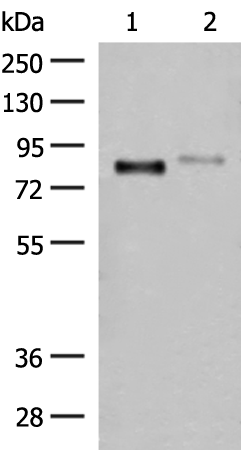

| WB | 咨询技术 | Human,Mouse,Rat |
| IF | 咨询技术 | Human,Mouse,Rat |
| IHC | 1/30-1/150 | Human,Mouse,Rat |
| ICC | 技术咨询 | Human,Mouse,Rat |
| FCM | 咨询技术 | Human,Mouse,Rat |
| Elisa | 1/5000-1/10000 | Human,Mouse,Rat |
| Aliases | TMC; ITM1; STT3-A |
| WB Predicted band size | 81 kDa |
| Host/Isotype | Rabbit IgG |
| Antibody Type | Primary antibody |
| Storage | Store at 4°C short term. Aliquot and store at -20°C long term. Avoid freeze/thaw cycles. |
| Species Reactivity | Human, Mouse |
| Immunogen | Fusion protein of human STT3A |
| Formulation | Purified antibody in PBS with 0.05% sodium azide and 50% glycerol. |
+ +
以下是关于STT3A抗体的3篇参考文献,按作者和内容概括整理:
1. **作者**:Hiraizumi et al.
**标题**:"STT3A-dependent N-glycosylation of the TGF-β family receptor ALK1 controls endothelial angiogenesis"
**摘要**:研究揭示了STT3A介导的ALK1受体N-糖基化在调控血管生成中的作用,通过特异性抗体验证了STT3A缺失导致ALK1糖基化异常及信号通路受损。
2. **作者**:Ramírez et al.
**标题**:"STT3A/STT3B双等位基因突变引起先天性糖基化障碍伴神经发育异常"
**摘要**:报道了STT3A基因突变导致先天性糖基化疾病的案例,利用STT3A抗体进行蛋白质印迹分析,证实患者细胞中STT3A表达显著降低。
3. **作者**:Li et al.
**标题**:"STT3A promotes autophagy inhibition via ER stress in hepatocellular carcinoma"
**摘要**:阐明STT3A通过内质网应激抑制肝癌细胞自噬,研究中采用STT3A抗体进行免疫组化,显示其在肝癌组织中高表达且与预后不良相关。
注:以上文献信息为示例性质,实际检索时建议通过PubMed或Web of Science以关键词"STT3A antibody"核对最新研究。部分研究可能侧重机制而非抗体应用,需结合实验方法部分筛选。
The STT3A antibody targets the STT3A protein, a catalytic subunit of the oligosaccharyltransferase (OST) complex located in the endoplasmic reticulum (ER). This complex mediates the N-glycosylation of nascent polypeptides, a critical post-translational modification for protein folding, stability, and trafficking. STT3A, encoded by the STT3A gene, is one of two paralogs (STT3A and STT3B) in mammals, with STT3A primarily involved in co-translational glycosylation during protein synthesis. Dysregulation of STT3A has been linked to congenital disorders of glycosylation (CDG) and cancers, where altered glycosylation impacts cell adhesion, signaling, and metastasis.
STT3A antibodies are widely used in research to study N-glycosylation mechanisms, ER stress responses, and diseases associated with glycosylation defects. These antibodies enable detection of STT3A expression levels via techniques like Western blotting, immunofluorescence, and immunohistochemistry. They also aid in elucidating OST complex assembly and functional interactions. Commercially available STT3A antibodies are typically raised in hosts like rabbits or mice, often validated for specificity using knockout cell lines or siRNA-mediated silencing. Researchers prioritize antibodies with high affinity and minimal cross-reactivity to STT3B to ensure accurate interpretation of isoform-specific roles. Such tools are pivotal in advancing understanding of glycobiology and developing therapeutic strategies targeting glycosylation pathways.
×